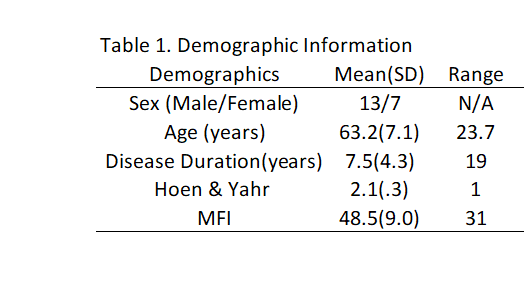Category: Parkinson's Disease: Non-Motor Symptoms
Objective: This project aims to explore the experience of fatigue in Parkinson’s patients, and its influence on gait variability in stride frequency and ground contact time.
Background: Half of patients with Parkinson’s disease (PD) report fatigue as a major disabling symptom.1 It interferes with daily mobility and productivity in addition to reducing quality of life.2 Fatigue can be defined as “the general sensation of tiredness or difficulty in initiating a physical or mental (cognitive) activity”.3 Perceived fatigue has been linked to walking difficulties experienced during daily activities, and associated with postural impairments and gait disturbances in adults with PD.4 We hypothesize that adults with PD who report fatigue will have greater gait disturbances and greater variability in stride frequency (SF) and ground contact time (CT) than those who do not report fatigue.
Method: 20 participants with PD were recruited for this study (11 Fatigue group, 9 non-Fatigue group). Demographic information is shown in [table1]. The presence of fatigue was determined by 48 or higher the Multidimensional Fatigue Inventory (MFI-20).5 In the initial session, participants became familiarized with the testing environment and with the walking task. In the experimental session participants walked straight for 30 minutes through three long walking lanes (1.2 m width by 28 m length) at a self-selected speed. Accelerometer data from the lumbar sensor was used to eliminate turns and segment gait cycles.
Results: There were no significant differences in average SF or average CT between the two groups as seen in [table2]. There were also no significant differences in the coefficient of variability for average SF or coefficient of variability for CT. However, there was a trend of greater variability in CT for participants with fatigue and a trend of greater variability in SF for participants without fatigue.
Conclusion: Contrary to our hypothesis, only SF showed more variability in the fatigue group, while those without fatigue had more variability in CT. This may suggest that participants with and without fatigue prioritize different aspects of gait during prolonged walking or develop strategies to compensate for their fatigue. Further research on fatigue and its influence on mobility is necessary for optimizing treatment options for people with PD who experience fatigue.
Table 1.
Table 2.
References: 1. Siciliano M, Trojano L, Santangelo G, De Micco R, Tedeschi G, Tessitore A. Fatigue in Parkinson’s
disease: A systematic review and meta-analysis. Mov Disord. Nov 2018;33(11):1712-1723. doi:10.1002/mds.27461
2. Stocchi F, Abbruzzese G, Ceravolo R, et al. Prevalence of fatigue in Parkinson disease and its clinical correlates. Neurology. Jul 15 2014;83(3):215-20. doi:10.1212/wnl.0000000000000587
3. Walker LAS, Lindsay-Brown AP, Berard JA. Cognitive Fatigability Interventions in Neurological Conditions: A Systematic Review. Neurol Ther. Dec 2019;8(2):251-271. doi:10.1007/s40120-019-00158-3
4. Pretzer-Aboff I, Galik E, Resnick B. Parkinson’s disease: barriers and facilitators to optimizing function. Rehabil Nurs. Mar-Apr 2009;34(2):55-63, 83.
5. Smets EM, Garssen B, Bonke B, De Haes JC. The Multidimensional Fatigue Inventory (MFI) psychometric qualities of an instrument to assess fatigue. J Psychosom Res. Apr 1995;39(3):315-25. doi:10.1016/0022-3999(94)00125-o
To cite this abstract in AMA style:
I. Sierra, S. Perfetto, A. Potvin-Desrochers, C. Mvomo, J. Bedime, H. Lajeunesse, F. Parent-L'Ecuye, C. Paquette. Influence of Fatigue in Parkinson’s Disease on Variability of Gait Measures [abstract]. Mov Disord. 2024; 39 (suppl 1). https://www.mdsabstracts.org/abstract/influence-of-fatigue-in-parkinsons-disease-on-variability-of-gait-measures/. Accessed December 12, 2025.« Back to 2024 International Congress
MDS Abstracts - https://www.mdsabstracts.org/abstract/influence-of-fatigue-in-parkinsons-disease-on-variability-of-gait-measures/


